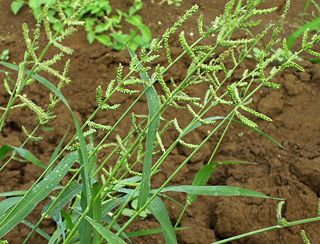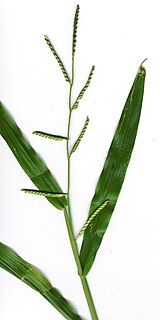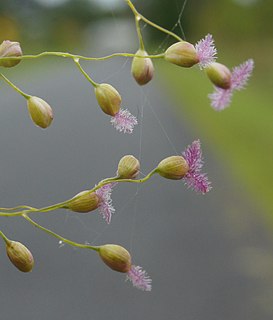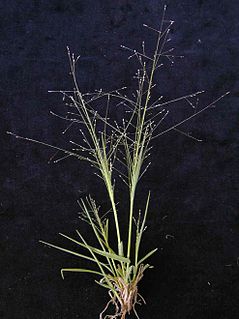
Panicum (panicgrass) is a large genus of about 450 species of grasses native throughout the tropical regions of the world, with a few species extending into the northern temperate zone. They are often large, annual or perennial grasses, growing to 1–3 m tall.

Echinochloa colona, commonly known as jungle rice, deccan grass, or awnless barnyard grass, is a type of wild grass originating from tropical Asia. It was formerly classified as a species of Panicum. It is the wild ancestor of the cultivated cereal crop Echinochloa frumentacea, sawa millet. Some taxonomists treat the two taxa as one species, in which case the domesticated forms may also be referred to as E. colona.

Echinochloa crus-galli is a type of wild grass originating from tropical Asia that was formerly classified as a type of panicum grass. It is commonly known as cockspur, barnyard millet, Japanese millet, water grass, common barnyard grass, or simply "barnyard grass". This plant can grow to 60" in height and has long, flat leaves which are often purplish at the base. Most stems are upright, but some will spread out over the ground. Stems are flattened at the base. The seed heads are a distinctive feature, often purplish, with large millet-like seeds in crowded spikelets.

Panicum antidotale Retz. is a tall, coarse, woody perennial grass throughout the Himalaya and the Upper Gangetic Plain and specifically in various regions of the Indian state of Punjab and the Pakistan province of Punjab and the neighbouring areas of these regions. The plant has strong spreading rhizomes.

Brachiaria, or signalgrass, is a genus of plants in the grass family native to tropical and subtropical regions of Asia, Africa, Australia, southern Europe, the Americas, and various islands. There are over 100 species.

Sacciolepis is a genus of plants in the grass family. Cupscale grass is a common name for plants in this genus.

Hymenachne is a genus of widespread wetlands plants that is in the grass family. They may be known commonly as marsh grasses. They are distributed in tropical and subtropical regions of Asia, the Americas, and the Pacific Islands. A species from the Americas, H. amplexicaulis, is well known in other parts of the world as an introduced and invasive species.

Isachne is a widespread genus of tropical and subtropical plants in the grass family, found in Asia, Africa, Australia, the Americas, and various oceanic islands. They may be known generally as bloodgrasses.

Neurachne, commonly called mulga grass, is a genus of Australian plants in the grass family.

Megathyrsus maximus, known as Guinea grass and green panic grass in English, is a large perennial bunch grass that is native to Africa and Yemen. It has been introduced in the tropics around the world. Until 2003, it was named Urochloa maxima. It was moved to genus Megathyrsus, which it shares with one other species, M. infestus.

Panicum effusum, commonly known as hairy panic, is a grass native to inland Australia. It occurs in every mainland state, as well as New Guinea. In dry conditions, the fast-growing grass can become a tumbleweed.

Panicum niihauense is a rare species of grass known by the common names lau 'ehu and Niihau panicgrass. It is endemic to Hawaii, where it has been found on the islands of Niihau and Kauai. It has not been observed on Niihau since 1949, and there are fewer than 40 individuals remaining on Kauai, not counting a few individuals that have been deliberately planted in appropriate habitat. The grass is a federally listed endangered species of the United States.

Panicum repens is a species of grass known by many common names, including torpedograss, creeping panic, panic rampant, couch panicum, wainaku grass, quack grass, dog-tooth grass, and bullet grass. Its exact native range is obscure. Sources suggest that the grass is native to "Africa and/or Asia", "Europe or Australia", "Eurasia", "Australia", "Europe, Asia, and Africa", or other specific regions, including the Mediterranean, Israel, and Argentina. It is present in many places as an introduced species and often a noxious weed. It has been called "one of the world's worst weeds."

Entolasia stricta, commonly known as wiry panic, is a species of right angled grass in the family Poaceae. It is found in eastern Australia on sandy or sandstone-based soils. The leaves are inrolled or curved inwards and somewhat rough to the touch. It first appeared in scientific literature in 1810 as Panicum strictum in the Prodromus Florae Novae Hollandiae, authored by the prolific Scottish botanist Robert Brown. It was given its current name in 1923.

Panicum coloratum is a species of grass known by the common names kleingrass, blue panicgrass (USA), white buffalograss ; Bambatsi panic, makarikari grass, and coolah grass (Australia). It is native to Africa, and it has been introduced elsewhere, such as the United States and Australia, and bred into many cultivars.
Ephysteris promptella, the ratoon shootborer, is a moth of the family Gelechiidae. It is a pantropical species, found in the warmer parts of the Old World tropics to Australia. It is widely distributed in southern Europe.

Paniceae is a large tribe of the subfamily Panicoideae in the grasses (Poaceae), the only in the monotypic supertribe Panicodae. It includes roughly 1,500 species in 84 genera, primarily found in tropical and subtropical regions of the world. Paniceae includes species using either of the C4 and C3 photosynthetic pathways, as well as presumably intermediate species. Most of the millets are members of tribe Paniceae.

Panicum hillmanii, commonly known as Hillmann's panicgrass, is a grass from genus Panicum native to Southwestern United States. It has been introduced to many other areas, notably including southern Australia where it became widespread, and several parts of Europe.

Panicum simile, known by the common name two colour panic, is a species of grass found in eastern Australia. It was described by Karel Domin in 1915.

















